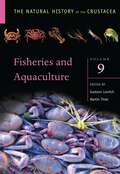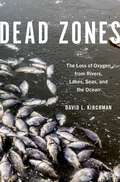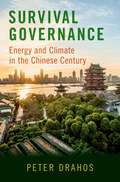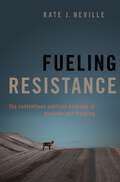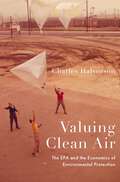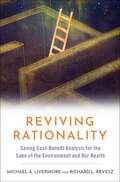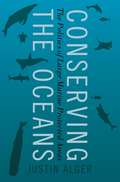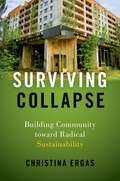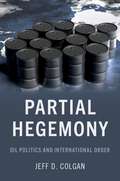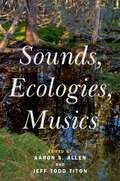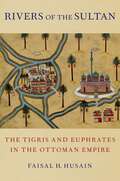- Table View
- List View
The Oxford Handbook of Comparative Environmental Politics (OXFORD HANDBOOKS SERIES)
The complexities and scope of environmental issues have not only outpaced the capacities and responsiveness of traditional political actors but also generated new innovations, constituencies, and approaches to governing environmental problems. In response, comparative environmental politics (CEP) has emerged as a vibrant and growing field of scholarly inquiry, embracing new questions and methods even as it addresses enduring questions in the broader field of comparative politics. Utilizing a range of methodological approaches, The Oxford Handbook of Comparative Environmental Politics delves into more traditional forms of CEP--the political economy of natural resources and the role of corporations and supply chains--while also showcasing new trends in CEP scholarship, particularly the comparative study of environmental injustice and intersectional inequities. Moving beyond the field's earlier work that focused on cross-national comparisons of political institutions, regulatory styles, and state-society relations, the Handbook includes approaches from political science, anthropology, sociology, geography, gender theory, law, human rights, and development studies. Moreover, the chapters highlight scholarship from a broader range of regions, and analyze the construction and diffusion of norms, rights, ethics, and ideology across the globe and through various social movements (with a focus on approaches from the Global South). Including 42 chapters, organized across 9 sections, The Oxford Handbook of Comparative Environmental Politics explores some of the most important environmental issues through the lens of comparative politics, including energy, climate change, food, health, urbanization, waste, and sustainability.
The Oxford Handbook of Comparative Environmental Politics (OXFORD HANDBOOKS SERIES)
by Jeannie Sowers, Stacy D. Vandeveer and Erika WeinthalThe complexities and scope of environmental issues have not only outpaced the capacities and responsiveness of traditional political actors but also generated new innovations, constituencies, and approaches to governing environmental problems. In response, comparative environmental politics (CEP) has emerged as a vibrant and growing field of scholarly inquiry, embracing new questions and methods even as it addresses enduring questions in the broader field of comparative politics. Utilizing a range of methodological approaches, The Oxford Handbook of Comparative Environmental Politics delves into more traditional forms of CEP--the political economy of natural resources and the role of corporations and supply chains--while also showcasing new trends in CEP scholarship, particularly the comparative study of environmental injustice and intersectional inequities. Moving beyond the field's earlier work that focused on cross-national comparisons of political institutions, regulatory styles, and state-society relations, the Handbook includes approaches from political science, anthropology, sociology, geography, gender theory, law, human rights, and development studies. Moreover, the chapters highlight scholarship from a broader range of regions, and analyze the construction and diffusion of norms, rights, ethics, and ideology across the globe and through various social movements (with a focus on approaches from the Global South). Including 42 chapters, organized across 9 sections, The Oxford Handbook of Comparative Environmental Politics explores some of the most important environmental issues through the lens of comparative politics, including energy, climate change, food, health, urbanization, waste, and sustainability.
Fisheries and Aquaculture: Volume 9 (The Natural History of the Crustacea)
by Gustavo Lovrich, Martin ThielThis is the ninth volume of ten in the The Natural History of the Crustacea Series. The chapters in this volume synthesize the diverse topics in fisheries and aquaculture. In the first part of the book, chapters explore worldwide crustacean fisheries. This section comes to a conclusion with two chapters on harvested crustaceans that are usually not within the focus of the mainstream fisheries research, possibly because they are caught by local fishing communities in small-scale operations and sold locally as subsistence activity. In the second part of the book, the authors explore the variety of cultured crustacean species, like shrimps, prawns, lobsters, and crabs. Chapters in the third part of the volume focus on important challenges and opportunities, including diseases and parasitism, the use of crustacean as bioindicators, and their role in biotechnology.
Dead Zones: The Loss of Oxygen from Rivers, Lakes, Seas, and the Ocean
by David L. KirchmanDead zones are on the rise... Human activity has caused an increase in uninhabitable, oxygen-poor zones--also known as "dead zones"--in our waters. Oxygen is the third most abundant element in the universe, and it is a necessity for nearly all life on Earth. Yet many rivers, estuaries, coastal waters, and parts of the open ocean lack enough of it. In this book, David L. Kirchman explains the impacts of dead zones and provides an in-depth history of oxygen loss in water. He details the role the agricultural industry plays in water pollution, showcasing how fertilizers contaminate water supplies and kickstart harmful algal blooms in local lakes, reservoirs, and coastal oceans. Algae decomposition requires so much oxygen that levels drop low enough to kill fish, destroy bottom-dwelling biota, reduce biological diversity, and rearrange food webs. We can't undo the damage completely, but we can work together to reduce the size and intensity of dead zones in places like the Gulf of Mexico, Chesapeake Bay, and the Baltic Sea. Not only does Kirchman clearly outline what dead zones mean for humanity, he also supplies ways we can reduce their deadly impact on human and aquatic life. Nutrient pollution in some regions has already begun to decline because of wastewater treatment, buffer zones, cover crops, and precision agriculture. More needs to be done, though, to reduce the harmful impact of existing dead zones and to stop the thousands of new ones from cropping up in our waters. Kirchman provides insight into the ways changing our diet can reduce nutrient pollution while also lowering greenhouse gasses emitted by the agricultural industry. Individuals can do something positive for their health and the world around them. The resulting book allows readers interested in the environment--whether students, policymakers, ecosystem managers, or science buffs--to dive into these deadly zones and discover how they can help mitigate the harmful effects of oxygen-poor waters today.
Dead Zones: The Loss of Oxygen from Rivers, Lakes, Seas, and the Ocean
by David L. KirchmanDead zones are on the rise... Human activity has caused an increase in uninhabitable, oxygen-poor zones--also known as "dead zones"--in our waters. Oxygen is the third most abundant element in the universe, and it is a necessity for nearly all life on Earth. Yet many rivers, estuaries, coastal waters, and parts of the open ocean lack enough of it. In this book, David L. Kirchman explains the impacts of dead zones and provides an in-depth history of oxygen loss in water. He details the role the agricultural industry plays in water pollution, showcasing how fertilizers contaminate water supplies and kickstart harmful algal blooms in local lakes, reservoirs, and coastal oceans. Algae decomposition requires so much oxygen that levels drop low enough to kill fish, destroy bottom-dwelling biota, reduce biological diversity, and rearrange food webs. We can't undo the damage completely, but we can work together to reduce the size and intensity of dead zones in places like the Gulf of Mexico, Chesapeake Bay, and the Baltic Sea. Not only does Kirchman clearly outline what dead zones mean for humanity, he also supplies ways we can reduce their deadly impact on human and aquatic life. Nutrient pollution in some regions has already begun to decline because of wastewater treatment, buffer zones, cover crops, and precision agriculture. More needs to be done, though, to reduce the harmful impact of existing dead zones and to stop the thousands of new ones from cropping up in our waters. Kirchman provides insight into the ways changing our diet can reduce nutrient pollution while also lowering greenhouse gasses emitted by the agricultural industry. Individuals can do something positive for their health and the world around them. The resulting book allows readers interested in the environment--whether students, policymakers, ecosystem managers, or science buffs--to dive into these deadly zones and discover how they can help mitigate the harmful effects of oxygen-poor waters today.
Survival Governance: Energy and Climate in the Chinese Century
by Peter DrahosTo deal with the climate crisis we need a new paradigm of technological and social development aimed at the restoration of ecological systems--the bio-digital energy paradigm--and China is the world power best positioned to lead this change. The climate and energy crisis requires a strong state to change the direction, speed, and scale of innovation in world capitalism. There are only a few possible contenders for catalyzing this governance of survival: China, the European Union, India, and the United States. While China is an improbable leader--and in fact the world's biggest emitter of greenhouse gasses--Peter Drahos explains in Survival Governance why this authoritarian state is actually more likely to implement systemic change swiftly and effectively than any other power. Drawing on more than 250 interviews, carried out in 17 countries--including the world's four largest carbon emitters--Drahos shows what China is doing to make its vast urban network sustainable and why all states must work toward a "bio-digital energy paradigm" based on a globalized, city-based network of innovation. As Drahos explains, America is incapable of reducing the power of its fossil fuel industry. For its part, the European Union's approach is too incremental and slowed by complex internal negotiations to address a crisis that demands a rapid response. India's capacity to be a global leader on energy innovation is questionable. To be sure, China faces hurdles too. Its coal-based industrial system is enormous, and the US, worried about losing technological superiority, is trying to slow China's development. Even so, China is currently urbanizing innovation on a historically unprecedented scale, building eco-cities, hydrogen cities, forest cities, and sponge cities (designed to cope with flooding). This has the potential to move cities into a new relationship with their surrounding ecosystems. China--given the size of its economy and the central government's ability to dictate thoroughgoing policy change--is, despite all of its flaws, presently our best hope for implementing the sort of policy overhaul that can begin to slow climate change.
Survival Governance: Energy and Climate in the Chinese Century
by Peter DrahosTo deal with the climate crisis we need a new paradigm of technological and social development aimed at the restoration of ecological systems--the bio-digital energy paradigm--and China is the world power best positioned to lead this change. The climate and energy crisis requires a strong state to change the direction, speed, and scale of innovation in world capitalism. There are only a few possible contenders for catalyzing this governance of survival: China, the European Union, India, and the United States. While China is an improbable leader--and in fact the world's biggest emitter of greenhouse gasses--Peter Drahos explains in Survival Governance why this authoritarian state is actually more likely to implement systemic change swiftly and effectively than any other power. Drawing on more than 250 interviews, carried out in 17 countries--including the world's four largest carbon emitters--Drahos shows what China is doing to make its vast urban network sustainable and why all states must work toward a "bio-digital energy paradigm" based on a globalized, city-based network of innovation. As Drahos explains, America is incapable of reducing the power of its fossil fuel industry. For its part, the European Union's approach is too incremental and slowed by complex internal negotiations to address a crisis that demands a rapid response. India's capacity to be a global leader on energy innovation is questionable. To be sure, China faces hurdles too. Its coal-based industrial system is enormous, and the US, worried about losing technological superiority, is trying to slow China's development. Even so, China is currently urbanizing innovation on a historically unprecedented scale, building eco-cities, hydrogen cities, forest cities, and sponge cities (designed to cope with flooding). This has the potential to move cities into a new relationship with their surrounding ecosystems. China--given the size of its economy and the central government's ability to dictate thoroughgoing policy change--is, despite all of its flaws, presently our best hope for implementing the sort of policy overhaul that can begin to slow climate change.
Fueling Resistance: The Contentious Political Economy of Biofuels and Fracking
by Kate J. NevilleA series of concurrent pressures in the early 2000s--climate change, financial system crashes, economic development in rural regions, and shifts in geopolitics--intensified interest in alternative energy production. At the same time, rising oil prices rendered alternative fuels a more economically viable option. Among these energy sources, liquid biofuels (bioethanol and biodiesel) and natural gas derived from hydraulic fracturing ("fracking") took center stage as promising commodities and technologies. But controversy quickly erupted in surprisingly similar ways around both renewable fuels. Global enthusiasm for these fuels--and the widespread projections for their production around the world--collided with local politics in debates over "food versus fuel" and concerns over "land grabs." What seemed, from a global perspective, like empty lands ripe for development were, to rural communities, vibrant and already contested spaces. As proposals for biofuels and fracking landed in specific communities and ecosystems, they reignited and reshaped old disputes over land, water, and decision-making authority. Fueling Resistance offers an account of how and why controversies over these different fuels unfolded in surprisingly similar ways in the global North and South. To explain these convergent dynamics of contention and resistance, Kate J. Neville argues that the emergence of grievances and the patterns of resistance to new fuel technologies depends less on the type of energy developed (renewable versus fossil fuel) than on intersecting elements of the political economy of energy: finance, ownership, and trade relations. As local commodities enter global supply chains and are integrated into existing corporate structures, opportunities arise to broker connections between otherwise disparate communities. Neville looks at biofuels in Kenya and fracking in the Canadian Yukon and shows how organizers connect specific energy projects to broader issues of globalization, climate, food, water, and justice. Taken together, the intersecting elements of the political economy of energy shape the contentious politics of biofuels and fracking at both local and global scales, and help explain how and why particular mechanisms of contention emerge at different times and places.
Fueling Resistance: The Contentious Political Economy of Biofuels and Fracking
by Kate J. NevilleA series of concurrent pressures in the early 2000s--climate change, financial system crashes, economic development in rural regions, and shifts in geopolitics--intensified interest in alternative energy production. At the same time, rising oil prices rendered alternative fuels a more economically viable option. Among these energy sources, liquid biofuels (bioethanol and biodiesel) and natural gas derived from hydraulic fracturing ("fracking") took center stage as promising commodities and technologies. But controversy quickly erupted in surprisingly similar ways around both renewable fuels. Global enthusiasm for these fuels--and the widespread projections for their production around the world--collided with local politics in debates over "food versus fuel" and concerns over "land grabs." What seemed, from a global perspective, like empty lands ripe for development were, to rural communities, vibrant and already contested spaces. As proposals for biofuels and fracking landed in specific communities and ecosystems, they reignited and reshaped old disputes over land, water, and decision-making authority. Fueling Resistance offers an account of how and why controversies over these different fuels unfolded in surprisingly similar ways in the global North and South. To explain these convergent dynamics of contention and resistance, Kate J. Neville argues that the emergence of grievances and the patterns of resistance to new fuel technologies depends less on the type of energy developed (renewable versus fossil fuel) than on intersecting elements of the political economy of energy: finance, ownership, and trade relations. As local commodities enter global supply chains and are integrated into existing corporate structures, opportunities arise to broker connections between otherwise disparate communities. Neville looks at biofuels in Kenya and fracking in the Canadian Yukon and shows how organizers connect specific energy projects to broader issues of globalization, climate, food, water, and justice. Taken together, the intersecting elements of the political economy of energy shape the contentious politics of biofuels and fracking at both local and global scales, and help explain how and why particular mechanisms of contention emerge at different times and places.
Valuing Clean Air: The EPA and the Economics of Environmental Protection
by Charles HalvorsonThe passage of the Clean Air Act and the creation of the Environmental Protection Agency (EPA) in 1970 marked a sweeping transformation in American politics. In a few short years, the environmental movement pushed Republican and Democratic elected officials to articulate a right to clean air as part of a bevy of new federal guarantees. Charged with delivering on those promises, the EPA represented a bold assertion that the federal government had a responsibility to protect the environment, the authority to command private business to reduce their pollution, and the capacity to dictate how they did so. In Valuing Clean Air, Charles Halvorson examines how the environmental concern that propelled the Clean Air Act and the EPA coincided with economic convulsions that shook the liberal state to its core. Business groups, public interest organizations, think tanks, and a host of other actors, including Ralph Nader, wasted little time after the EPA's creation in identifying and trying to pull the new levers of power. As powerful businesses pressed to roll back regulations, elected officials from both political parties questioned whether the nation could keep its environmental promises. In response, the EPA's staff and leadership practiced a politics of the possible, adopting a monetized approach to environmental value that shielded the agency's rulemaking but sat at odds with environmentalist notions of natural rights and contributed to the elevation of economics as the language and logic of policy. As Halvorson demonstrates, environmental protection came to serve as a central battleground in larger debates over markets, government, and public welfare. For anyone who has wondered where cap and trade came from and how environmental activists came to discuss wetlands protection, air pollution, and fracking in the language of cost-benefit analysis, Valuing Clean Air provides an insightful look at a half-century of the making of US environmental policy.
Valuing Clean Air: The EPA and the Economics of Environmental Protection
by Charles HalvorsonThe passage of the Clean Air Act and the creation of the Environmental Protection Agency (EPA) in 1970 marked a sweeping transformation in American politics. In a few short years, the environmental movement pushed Republican and Democratic elected officials to articulate a right to clean air as part of a bevy of new federal guarantees. Charged with delivering on those promises, the EPA represented a bold assertion that the federal government had a responsibility to protect the environment, the authority to command private business to reduce their pollution, and the capacity to dictate how they did so. In Valuing Clean Air, Charles Halvorson examines how the environmental concern that propelled the Clean Air Act and the EPA coincided with economic convulsions that shook the liberal state to its core. Business groups, public interest organizations, think tanks, and a host of other actors, including Ralph Nader, wasted little time after the EPA's creation in identifying and trying to pull the new levers of power. As powerful businesses pressed to roll back regulations, elected officials from both political parties questioned whether the nation could keep its environmental promises. In response, the EPA's staff and leadership practiced a politics of the possible, adopting a monetized approach to environmental value that shielded the agency's rulemaking but sat at odds with environmentalist notions of natural rights and contributed to the elevation of economics as the language and logic of policy. As Halvorson demonstrates, environmental protection came to serve as a central battleground in larger debates over markets, government, and public welfare. For anyone who has wondered where cap and trade came from and how environmental activists came to discuss wetlands protection, air pollution, and fracking in the language of cost-benefit analysis, Valuing Clean Air provides an insightful look at a half-century of the making of US environmental policy.
Reviving Rationality: Saving Cost-Benefit Analysis for the Sake of the Environment and Our Health
by Michael A. Livermore Richard L. ReveszFor decades, administrations of both political parties have used cost-benefit analysis to evaluate and improve federal policy in a variety of areas, including health and the environment. Today, this model is under grave threat. In Reviving Rationality, Michael Livermore and Richard Revesz explain how Donald Trump has destabilized the decades-long bipartisan consensus that federal agencies must base their decisions on evidence, expertise, and analysis. Administrative agencies are charged by law with protecting values like stable financial markets and clean air. Their decisions often have profound consequences, affecting everything from the safety of workplaces to access to the dream of home ownership. Under the Trump administration, agencies have been hampered in their ability to advance these missions by the conflicting ideological whims of a changing cast of political appointees and overwhelming pressure from well-connected interest groups. Inconvenient evidence has been ignored, experts have been sidelined, and analysis has been used to obscure facts, rather than inform the public. The results are grim: incoherent policy, social division, defeats in court, a demoralized federal workforce, and a loss of faith in government's ability to respond to pressing problems. This experiment in abandoning the norms of good governance has been a disaster. Reviving Rationality explains how and why our government has abandoned rationality in recent years, and why it is so important for future administrations to restore rigorous cost-benefit analysis if we are to return to a policymaking approach that effectively tackles the most pressing problems of our era.
Reviving Rationality: Saving Cost-Benefit Analysis for the Sake of the Environment and Our Health
by Richard L. Revesz Michael A. LivermoreFor decades, administrations of both political parties have used cost-benefit analysis to evaluate and improve federal policy in a variety of areas, including health and the environment. Today, this model is under grave threat. In Reviving Rationality, Michael Livermore and Richard Revesz explain how Donald Trump has destabilized the decades-long bipartisan consensus that federal agencies must base their decisions on evidence, expertise, and analysis. Administrative agencies are charged by law with protecting values like stable financial markets and clean air. Their decisions often have profound consequences, affecting everything from the safety of workplaces to access to the dream of home ownership. Under the Trump administration, agencies have been hampered in their ability to advance these missions by the conflicting ideological whims of a changing cast of political appointees and overwhelming pressure from well-connected interest groups. Inconvenient evidence has been ignored, experts have been sidelined, and analysis has been used to obscure facts, rather than inform the public. The results are grim: incoherent policy, social division, defeats in court, a demoralized federal workforce, and a loss of faith in government's ability to respond to pressing problems. This experiment in abandoning the norms of good governance has been a disaster. Reviving Rationality explains how and why our government has abandoned rationality in recent years, and why it is so important for future administrations to restore rigorous cost-benefit analysis if we are to return to a policymaking approach that effectively tackles the most pressing problems of our era.
Conserving the Oceans: The Politics of Large Marine Protected Areas
by Justin AlgerLarge marine protected areas (MPAs) have emerged since the mid-2000s as a popular state response to the overfishing, land run-off, and climate change causing the decline of the world's oceans. As of 2020, there were more than 14,000 MPAs in the world, most of them small, poorly managed, and often amounting to little more than "paper parks" that contribute little to ocean conservation or resource management. However, that is beginning to change. In recent years, governments, including the United States and United Kingdom, have turned their attention to protecting large swaths of ocean through MPAs hundreds of thousands of square kilometers in size. In this book, Justin Alger documents the efforts of activists and states to increase the pace and scale of global ocean protections, leading to a paradigm shift in how states conserve marine biodiversity. Through an analysis of domestic political economies, and based on three original MPA case studies located in the United States, Australia, and Palau, this book explains how states have protected millions of square kilometers of ocean space while remaining highly responsive to the interests of businesses. From the commercial fishing to ecotourism sectors, business heavily influences conservation policy, occasionally leading to robust protections but more often than not to business-as-usual activity on the water. Conserving the Oceans examines the reach and the limits of business influence, examining how the domestic political economy of a given ocean space can reshape a global norm to better suit local economic realities. While recognizing important global progress and growing ambition to conserve ocean ecosystems, Alger provides a critical analysis of the processes by which global environmental norms become domestic policy. Ultimately, the book questions if we are still doing too little to prevent the worst impacts of the global environmental crisis despite the paradigm shift in global ocean conservation.
Conserving the Oceans: The Politics of Large Marine Protected Areas
by Justin AlgerLarge marine protected areas (MPAs) have emerged since the mid-2000s as a popular state response to the overfishing, land run-off, and climate change causing the decline of the world's oceans. As of 2020, there were more than 14,000 MPAs in the world, most of them small, poorly managed, and often amounting to little more than "paper parks" that contribute little to ocean conservation or resource management. However, that is beginning to change. In recent years, governments, including the United States and United Kingdom, have turned their attention to protecting large swaths of ocean through MPAs hundreds of thousands of square kilometers in size. In this book, Justin Alger documents the efforts of activists and states to increase the pace and scale of global ocean protections, leading to a paradigm shift in how states conserve marine biodiversity. Through an analysis of domestic political economies, and based on three original MPA case studies located in the United States, Australia, and Palau, this book explains how states have protected millions of square kilometers of ocean space while remaining highly responsive to the interests of businesses. From the commercial fishing to ecotourism sectors, business heavily influences conservation policy, occasionally leading to robust protections but more often than not to business-as-usual activity on the water. Conserving the Oceans examines the reach and the limits of business influence, examining how the domestic political economy of a given ocean space can reshape a global norm to better suit local economic realities. While recognizing important global progress and growing ambition to conserve ocean ecosystems, Alger provides a critical analysis of the processes by which global environmental norms become domestic policy. Ultimately, the book questions if we are still doing too little to prevent the worst impacts of the global environmental crisis despite the paradigm shift in global ocean conservation.
World on Fire: Humans, Animals, and the Future of the Planet
by Mark RowlandsMark Rowlands presents a novel analysis of three epoch-defining environmental problems: climate, extinction, and pestilence. Our climate is changing at a rate that is unprecedented and, if unchecked, disastrous. Species are disappearing hundreds or thousands of times faster than normal. COVID-19 has wreaked social and economic havoc but is merely the latest off a blossoming production line of emerging infectious diseases, many of which have the potential to be far worse. Rowlands establishes that all three problems are consequences of choices we have made about energy, which can be divided into two major forms: fuel and food. Focusing on food choices as far more central to the issue than commonly recognized, he argues that the solution is breaking our collective habit of eating animals. Rowlands shows that in doing so, we stem our insatiable hunger for land, which he identifies as central to the problems of extinction and pestilence. He explains that reversing the industrial farming of animals for food will first, substantially cut climate emissions, rapidly enough to allow sustainable energy technologies time to become viable alternatives; and most importantly, make vast areas of a land available for the kind of aggressive afforestation policy that he shows as necessary to bring all three problems under control. With World on Fire, Mark Rowlands identifies the source of our environmental ills and provides a compelling and accessible account of how to solve them.
World on Fire: Humans, Animals, and the Future of the Planet
by Mark RowlandsMark Rowlands presents a novel analysis of three epoch-defining environmental problems: climate, extinction, and pestilence. Our climate is changing at a rate that is unprecedented and, if unchecked, disastrous. Species are disappearing hundreds or thousands of times faster than normal. COVID-19 has wreaked social and economic havoc but is merely the latest off a blossoming production line of emerging infectious diseases, many of which have the potential to be far worse. Rowlands establishes that all three problems are consequences of choices we have made about energy, which can be divided into two major forms: fuel and food. Focusing on food choices as far more central to the issue than commonly recognized, he argues that the solution is breaking our collective habit of eating animals. Rowlands shows that in doing so, we stem our insatiable hunger for land, which he identifies as central to the problems of extinction and pestilence. He explains that reversing the industrial farming of animals for food will first, substantially cut climate emissions, rapidly enough to allow sustainable energy technologies time to become viable alternatives; and most importantly, make vast areas of a land available for the kind of aggressive afforestation policy that he shows as necessary to bring all three problems under control. With World on Fire, Mark Rowlands identifies the source of our environmental ills and provides a compelling and accessible account of how to solve them.
Surviving Collapse: Building Community toward Radical Sustainability
by Christina ErgasAs major environmental crises loom, Christina Ergas makes the argument in Surviving Collapse that one possible way forward is a radical sustainable development that turns the focus from monetary gain to social and ecological regeneration and transformation. Employing qualitative and cross-national comparative methods, Ergas examines two alternative, community-scale, socioecological models of development: the first is a grassroots urban ecovillage in the Pacific Northwest, United States, while the second is a government-subsidized, but cooperatively run, urban farm in Havana, Cuba. While neither are panaceas, they prioritize social and ecological efficiency and subsume economic rationality towards those ends. Featuring cases that not only allow us to synthesize their strengths but evaluate their weaknesses, Surviving Collapse reveals a multitude of varied paths toward reaching radical urban sustainability and empowers us all to imagine, and possibly build, more resilient futures.
Surviving Collapse: Building Community toward Radical Sustainability
by Christina ErgasAs major environmental crises loom, Christina Ergas makes the argument in Surviving Collapse that one possible way forward is a radical sustainable development that turns the focus from monetary gain to social and ecological regeneration and transformation. Employing qualitative and cross-national comparative methods, Ergas examines two alternative, community-scale, socioecological models of development: the first is a grassroots urban ecovillage in the Pacific Northwest, United States, while the second is a government-subsidized, but cooperatively run, urban farm in Havana, Cuba. While neither are panaceas, they prioritize social and ecological efficiency and subsume economic rationality towards those ends. Featuring cases that not only allow us to synthesize their strengths but evaluate their weaknesses, Surviving Collapse reveals a multitude of varied paths toward reaching radical urban sustainability and empowers us all to imagine, and possibly build, more resilient futures.
Partial Hegemony: Oil Politics and International Order
by Jeff D. ColganThe global history of oil politics, from World War I to the present, can teach us much about world politics, climate change, and international order in the twenty-first century. When and why does international order change? The largest peaceful transfer of wealth across borders in all of human history began with the oil crisis of 1973. OPEC countries turned the tables on the most powerful businesses on the planet, quadrupling the price of oil and shifting the global distribution of profits. It represented a huge shift in international order. Yet, the textbook explanation for how world politics works-that the most powerful country sets up and sustains the rules of international order after winning a major war-doesn't fit these events, or plenty of others. Instead of thinking of "the" international order as a single thing, Jeff Colgan explains how it operates in parts, and often changes in peacetime. Partial Hegemony offers lessons for leaders and analysts seeking to design new international governing arrangements to manage an array of pressing concerns ranging from US-China rivalry to climate change, and from nuclear proliferation to peacekeeping. A major contribution to international relations theory, this book promises to reshape our understanding of the forces driving change in world politics.
Partial Hegemony: Oil Politics and International Order
by Jeff D. ColganThe global history of oil politics, from World War I to the present, can teach us much about world politics, climate change, and international order in the twenty-first century. When and why does international order change? The largest peaceful transfer of wealth across borders in all of human history began with the oil crisis of 1973. OPEC countries turned the tables on the most powerful businesses on the planet, quadrupling the price of oil and shifting the global distribution of profits. It represented a huge shift in international order. Yet, the textbook explanation for how world politics works-that the most powerful country sets up and sustains the rules of international order after winning a major war-doesn't fit these events, or plenty of others. Instead of thinking of "the" international order as a single thing, Jeff Colgan explains how it operates in parts, and often changes in peacetime. Partial Hegemony offers lessons for leaders and analysts seeking to design new international governing arrangements to manage an array of pressing concerns ranging from US-China rivalry to climate change, and from nuclear proliferation to peacekeeping. A major contribution to international relations theory, this book promises to reshape our understanding of the forces driving change in world politics.
Sounds, Ecologies, Musics
Sounds, Ecologies, Musics poses exciting challenges and provides fresh opportunities for scholars, scientists, environmental activists, musicians, and listeners to consider music and sound from ecological standpoints. Authors in Part I examine the natural and built environment and how music and sound are woven into it, how the environment enables music and sound, and how the natural and cultural production of music and sound in turn impact the environment. In Part II, contributors consider music and sound in relation to ecological knowledges that appear to conflict with, yet may be viewed as complementary to, Western science: traditional and Indigenous ecological and environmental knowledges. Part III features multidisciplinary and interdisciplinary approaches by scholars, scientists, and practitioners who probe the ecological imaginary regarding the complex ideas and contested keywords that characterize ecomusicology: sound, music, culture, society, environment, and nature. A common theme across the book is the idea of diverse ecologies. Once confined to the natural sciences, the word "ecology" is common today in the social sciences, humanities, and arts - yet its diverse uses have become imprecise and confusing. Engaging the conflicting and complementary meanings of "ecology" requires embracing a both/and approach. Diverse ecologies are illustrated in the methodological, terminological, and topical variety of the chapters as well as the contributors' choice of sources and their disciplinary backgrounds. In times of mounting human and planetary crises, Sounds, Ecologies, Musics challenges disciplinarity and broadens the interdisciplinary field of ecomusicologies. These theoretical and practical studies expand sonic, scholarly, and political activism from the diversity-equity-inclusion agenda of social justice to embrace the more diverse and inclusive agenda of ecocentric ecojustice.
Sounds, Ecologies, Musics
by Aaron S. Allen and Jeff Todd TitonSounds, Ecologies, Musics poses exciting challenges and provides fresh opportunities for scholars, scientists, environmental activists, musicians, and listeners to consider music and sound from ecological standpoints. Authors in Part I examine the natural and built environment and how music and sound are woven into it, how the environment enables music and sound, and how the natural and cultural production of music and sound in turn impact the environment. In Part II, contributors consider music and sound in relation to ecological knowledges that appear to conflict with, yet may be viewed as complementary to, Western science: traditional and Indigenous ecological and environmental knowledges. Part III features multidisciplinary and interdisciplinary approaches by scholars, scientists, and practitioners who probe the ecological imaginary regarding the complex ideas and contested keywords that characterize ecomusicology: sound, music, culture, society, environment, and nature. A common theme across the book is the idea of diverse ecologies. Once confined to the natural sciences, the word "ecology" is common today in the social sciences, humanities, and arts - yet its diverse uses have become imprecise and confusing. Engaging the conflicting and complementary meanings of "ecology" requires embracing a both/and approach. Diverse ecologies are illustrated in the methodological, terminological, and topical variety of the chapters as well as the contributors' choice of sources and their disciplinary backgrounds. In times of mounting human and planetary crises, Sounds, Ecologies, Musics challenges disciplinarity and broadens the interdisciplinary field of ecomusicologies. These theoretical and practical studies expand sonic, scholarly, and political activism from the diversity-equity-inclusion agenda of social justice to embrace the more diverse and inclusive agenda of ecocentric ecojustice.
Rivers of the Sultan: The Tigris and Euphrates in the Ottoman Empire
by Faisal H. HusainThe Tigris and Euphrates rivers run through the heart of the Middle East and merge in the area of Mesopotamia known as the "cradle of civilization." In their long and volatile political history, the sixteenth century ushered in a rare era of stability and integration. A series of military campaigns between the Mediterranean Sea and the Persian Gulf brought the entirety of their flow under the institutional control of the Ottoman Empire, then at the peak of its power and wealth. Rivers of the Sultan tells the history of the Tigris and Euphrates during the early modern period. Under the leadership of Sultan Süleyman I, the rivers became Ottoman from mountain to ocean, managed by a political elite that pledged allegiance to a single household, professed a common religion, spoke a lingua franca, and received orders from a central administration based in Istanbul. Faisal Husain details how Ottoman unification institutionalized cooperation among the rivers' dominant users and improved the exploitation of their waters for navigation and food production. Istanbul harnessed the energy and resources of the rivers for its security and economic needs through a complex network of forts, canals, bridges, and shipyards. Above all, the imperial approach to river management rebalanced the natural resource disparity within the Tigris-Euphrates basin. Istanbul regularly organized shipments of grain, metal, and timber from upstream areas of surplus in Anatolia to downstream areas of need in Iraq. Through this policy of natural resource redistribution, the Ottoman Empire strengthened its presence in the eastern borderland region with the Safavid Empire and fended off challenges to its authority. Placing these world historic bodies of water at its center, Rivers of the Sultan reveals intimate bonds between state and society, metropole and periphery, and nature and culture in the early modern world.
Rivers of the Sultan: The Tigris and Euphrates in the Ottoman Empire
by Faisal H. HusainThe Tigris and Euphrates rivers run through the heart of the Middle East and merge in the area of Mesopotamia known as the "cradle of civilization." In their long and volatile political history, the sixteenth century ushered in a rare era of stability and integration. A series of military campaigns between the Mediterranean Sea and the Persian Gulf brought the entirety of their flow under the institutional control of the Ottoman Empire, then at the peak of its power and wealth. Rivers of the Sultan tells the history of the Tigris and Euphrates during the early modern period. Under the leadership of Sultan Süleyman I, the rivers became Ottoman from mountain to ocean, managed by a political elite that pledged allegiance to a single household, professed a common religion, spoke a lingua franca, and received orders from a central administration based in Istanbul. Faisal Husain details how Ottoman unification institutionalized cooperation among the rivers' dominant users and improved the exploitation of their waters for navigation and food production. Istanbul harnessed the energy and resources of the rivers for its security and economic needs through a complex network of forts, canals, bridges, and shipyards. Above all, the imperial approach to river management rebalanced the natural resource disparity within the Tigris-Euphrates basin. Istanbul regularly organized shipments of grain, metal, and timber from upstream areas of surplus in Anatolia to downstream areas of need in Iraq. Through this policy of natural resource redistribution, the Ottoman Empire strengthened its presence in the eastern borderland region with the Safavid Empire and fended off challenges to its authority. Placing these world historic bodies of water at its center, Rivers of the Sultan reveals intimate bonds between state and society, metropole and periphery, and nature and culture in the early modern world.

